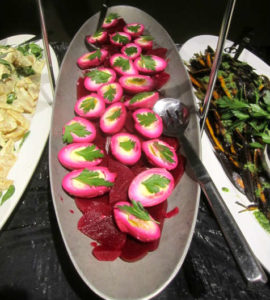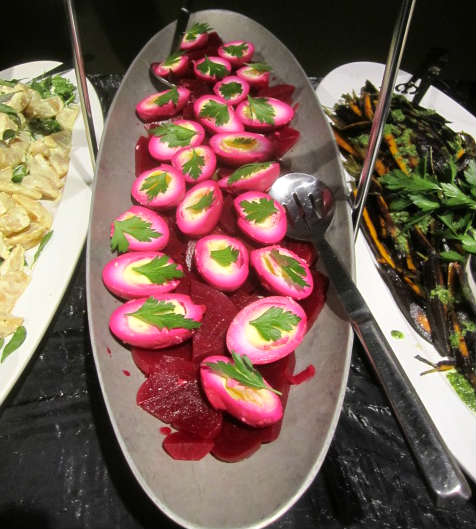We are all foragers. We search, scavenge, and gather food habitually. My daughter comes home from school and automatically opens the refrigerator and says, “there is nothing to eat in here,” despite it being filled with loads of food. Going to the grocery store is dangerous when hungry, as food items astoundingly show up in my cart despite my best intentions. Traveling the buffet line, my eyes are always bigger than my stomach, as everything looks delicious.

Gray Jays Foraging in a Hive in the William O. Douglas Wilderness
When hungry, we crave food just as our ancestors did and thus, become modern day hunter-gatherers. Granted we no longer kill an animal, but we stalk, search and eventually grab the food we yearn for, just as the gray jays in the wilderness poked and prodded the downed hive for bee bits observed on an early September backpacking trip. Our evolutionary heritage is alive and well in all of us today. For the first 1.8 million years of humans’ history we lived in the wild. We gathered nuts, berries, roots, and leaves and pursued game, caught fish, and snared birds and small animals. Humans could just as likely be a wild animal’s lunch, too. We lived one with nature, as we were integral to the ecosystem.
In what we now perceive as ancient history, 10,000 to 12,000 years ago, our ancestors started to cultivate plants and domesticate animals, at the same time slowly began our journey away from nature. The initial dawn of agriculture started in the Fertile Crescent, which is a swath of land stretching from what is now northern Egypt, the eastern Mediterranean countries encompassing Lebanon, Israel and Jordan, to the now northern Persian Gulf countries of Syria and Iraq. Animal domestication and plant cultivation continued to travel throughout the world with eastern North America adopting agricultural practices as late as 3,000 to 4,000 years ago. Amazingly the advent of agriculture is merely 0.2% to 0.7% of the total time that humans have been on this earth and it is not ancient history!

Stokesberry Duck Eggs with Ralph’s Greenhouse Beets found in the buffet line at the WA Sustainable Food & Farming Network Harvest Dinner
No wonder as we wander the grocery aisle, or peruse the farmer’s market or salivate in the buffet line, we tap into our hunter-gatherer instincts and gravitate towards certain foods. At my husband’s milestone birthday party, we celebrated with a tiramisu cake surrounded with lady fingers, topped with mascarpone frosting, and adorned with chocolate nibs–heavy, dense, and delicious. Thankfully, the cake is gone, because even writing this, my taste buds lust for just another morsel. My longings are totally normal, as Susan B. Roberts, Ph.D., author of The “I” Diet and professor of nutrition at Tufts University says, “In prehistory, calories were in intermittent supply and very essential for survival,” causing the human desire to crave food instinctively.
Now compared to our early ancestors, as a culture we have so much food that we can afford to throw excess away. Think of your last restaurant visit. Were you a member of the “clean plate club”? Or did you ask for a “take-away” container, to schlep food home for another meal? Did you remember to eat the stored meal? Or did it grow new forms of life and you pitched it? Our ancestors would never throw away food as it was unthinkable, unnecessary, and unwise, as they didn’t know where their next meal would come from.
More importantly than our cravings is the quality of the food we eat. Only since World War II have we mechanized, commoditized, petro-chemically fertilized and sprayed, and genetically modified the products grown in our mainstream food production system. This is a mere 70 years or 0.004% of our human existence and 0.7% of the 10,000 years of agricultural history. We are continually being assured and assuaged that our foods are safe for us and the environment, despite the findings that RoundUp is expected to be classified in California as carcinogen and therapeutic antibiotics are consistently being used in animals being grown for human consumption. RoundUp kills unwanted plants, but what other harm does it cause? The minimal amounts of therapeutic antibiotics found in mainstream meat products are now threatening the effectiveness of medicinal antibiotics used by people to treat life-frightening infections.
My solution is foraging at the Farmers Markets or PCC Natural Markets–my local food cooperative, and organic is my sought after label!
Kathryn Gardow, P.E., is a local food advocate, land use expert and owner of Gardow Consulting, LLC, an organization dedicated to providing multidisciplinary solutions to building sustainable communities. Kathryn has expertise in project management, planning, fundraising, and civil engineering, with an emphasis on creating communities that include food production. Kathryn is a Washington Sustainable Food and Farming Network board member and on the Urban Land Institute–Northwest District Council’s Center for Sustainable Leadership planning team. Kathryn’s blog muses on ways to create a more sustainable world and good food! (Thanks to Dennis Weaver of Change Your Food, Change Your Life for the great photos from the WSFFN Harvest Fest!)

